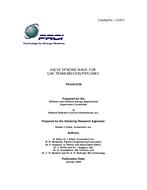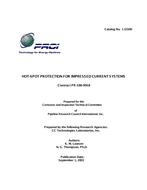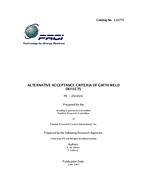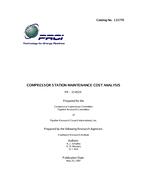Provide PDF Format
PRCI PR-249-9728
- Valve Spacing Basis For Gas Transmission Pipelines
- Report / Survey by Pipeline Research Council International, 01/01/2000
- Publisher: PRCI
$448.00$895.00
L51817e
Robert J. Eiber, Consultant, Inc.
Need: Fourteen pipeline design codes from ten countries (North America, Europe, and Australia) were previously reviewed in a study for the PRCI to identify their valve spacing requirements, valve closure requirements, class location definitions, pipeline corridor widths, and design factors. The valve spacing requirements in the various regulatory codes can be grouped into three categories: 1) Specified distances which vary by the population density adjacent to the pipeline (class location), 2) Spacing which limits the gas volume between valves, and 3) Distance that is defined by the operational requirements of the pipeline or is constant along the pipeline. Ten of the codes used population density to define the valve spacing requirements for gas pipelines. The previous PRCI study did not identify any clear technical rationale for the valve spacing in existing codes. The only basis identified for the existing valve spacing requirements is that they were developed by consensus in committees that consisted of industry representatives and regulatory staff and that these values have been accepted by the industry and regulatory bodies. The results of that study led to this study to develop a technical basis for valve spacing.
Benefit: This comprehensive report developed the basis for spacing of valves on gas transmission pipelines and includes three (3) sections: (1) A cost benefit analysis on valve spacing and includes a software program to help the user perform his/her own cost benefit analysis, (2) A risk analysis on valve spacing, and (3) A noise/blast wave analysis on valve spacing. Prediction of individual risk (that is the probability that an individual at a specified location will be a casualty) as a function of distance from the pipeline, as a result of a pipeline rupture, for each of the pipeline conditions specified as follows. Extensive testing and evaluation was performed for three different pipeline nominal diameters (42" (1067mm), 30" (762mm) and 18" (457mm)), two different operating pressures (35 and 75 bar), and three different valve spacings (8,16, and 32 Km).
Result: This study shows that to produce significant reductions in risk levels, for the pipelien conditions considered in this study, it would be necessary to install valves at intervals of no more than 16Km which could shut almost instantaneously following rupture. To achieve a significant level of risk reduction it would be necessary to install valves with a rapid response to any failure at short spacings along the pipeline. Benefits of risk reduction would then have to be assessed against the costs of installing large numbers of valves and also the effects of an increased probability of an erroneous valve shutdown.
Robert J. Eiber, Consultant, Inc.
Need: Fourteen pipeline design codes from ten countries (North America, Europe, and Australia) were previously reviewed in a study for the PRCI to identify their valve spacing requirements, valve closure requirements, class location definitions, pipeline corridor widths, and design factors. The valve spacing requirements in the various regulatory codes can be grouped into three categories: 1) Specified distances which vary by the population density adjacent to the pipeline (class location), 2) Spacing which limits the gas volume between valves, and 3) Distance that is defined by the operational requirements of the pipeline or is constant along the pipeline. Ten of the codes used population density to define the valve spacing requirements for gas pipelines. The previous PRCI study did not identify any clear technical rationale for the valve spacing in existing codes. The only basis identified for the existing valve spacing requirements is that they were developed by consensus in committees that consisted of industry representatives and regulatory staff and that these values have been accepted by the industry and regulatory bodies. The results of that study led to this study to develop a technical basis for valve spacing.
Benefit: This comprehensive report developed the basis for spacing of valves on gas transmission pipelines and includes three (3) sections: (1) A cost benefit analysis on valve spacing and includes a software program to help the user perform his/her own cost benefit analysis, (2) A risk analysis on valve spacing, and (3) A noise/blast wave analysis on valve spacing. Prediction of individual risk (that is the probability that an individual at a specified location will be a casualty) as a function of distance from the pipeline, as a result of a pipeline rupture, for each of the pipeline conditions specified as follows. Extensive testing and evaluation was performed for three different pipeline nominal diameters (42" (1067mm), 30" (762mm) and 18" (457mm)), two different operating pressures (35 and 75 bar), and three different valve spacings (8,16, and 32 Km).
Result: This study shows that to produce significant reductions in risk levels, for the pipelien conditions considered in this study, it would be necessary to install valves at intervals of no more than 16Km which could shut almost instantaneously following rupture. To achieve a significant level of risk reduction it would be necessary to install valves with a rapid response to any failure at short spacings along the pipeline. Benefits of risk reduction would then have to be assessed against the costs of installing large numbers of valves and also the effects of an increased probability of an erroneous valve shutdown.





